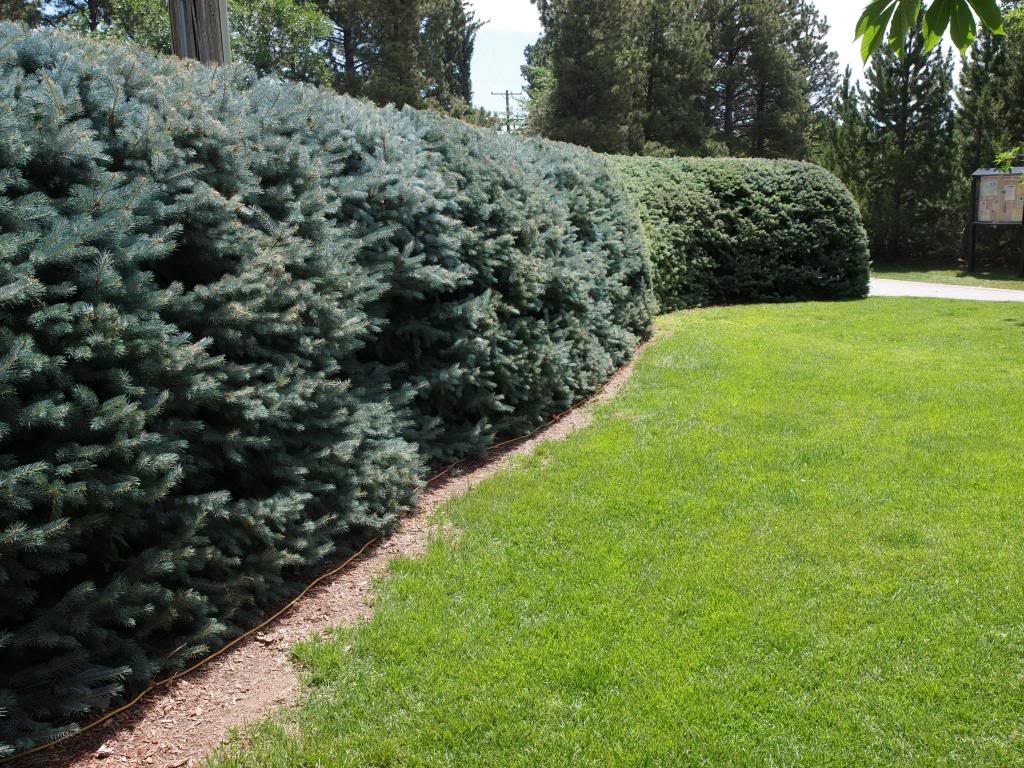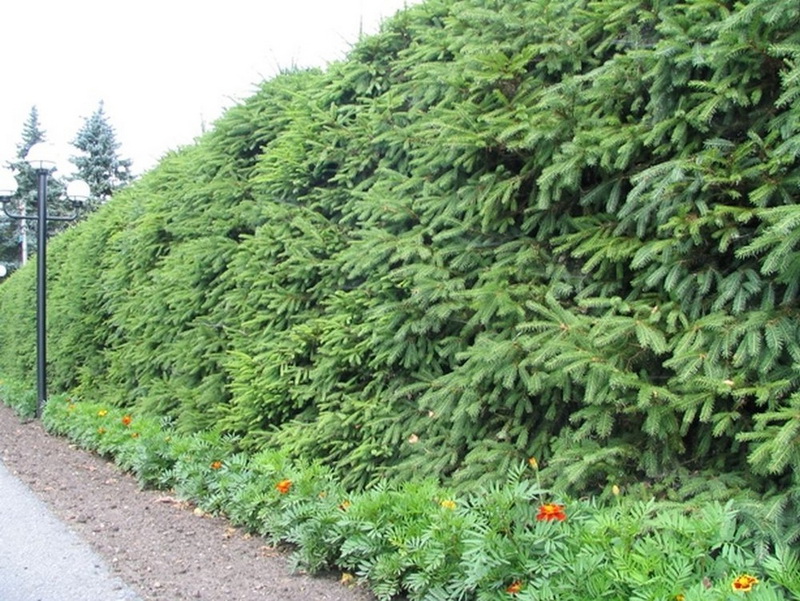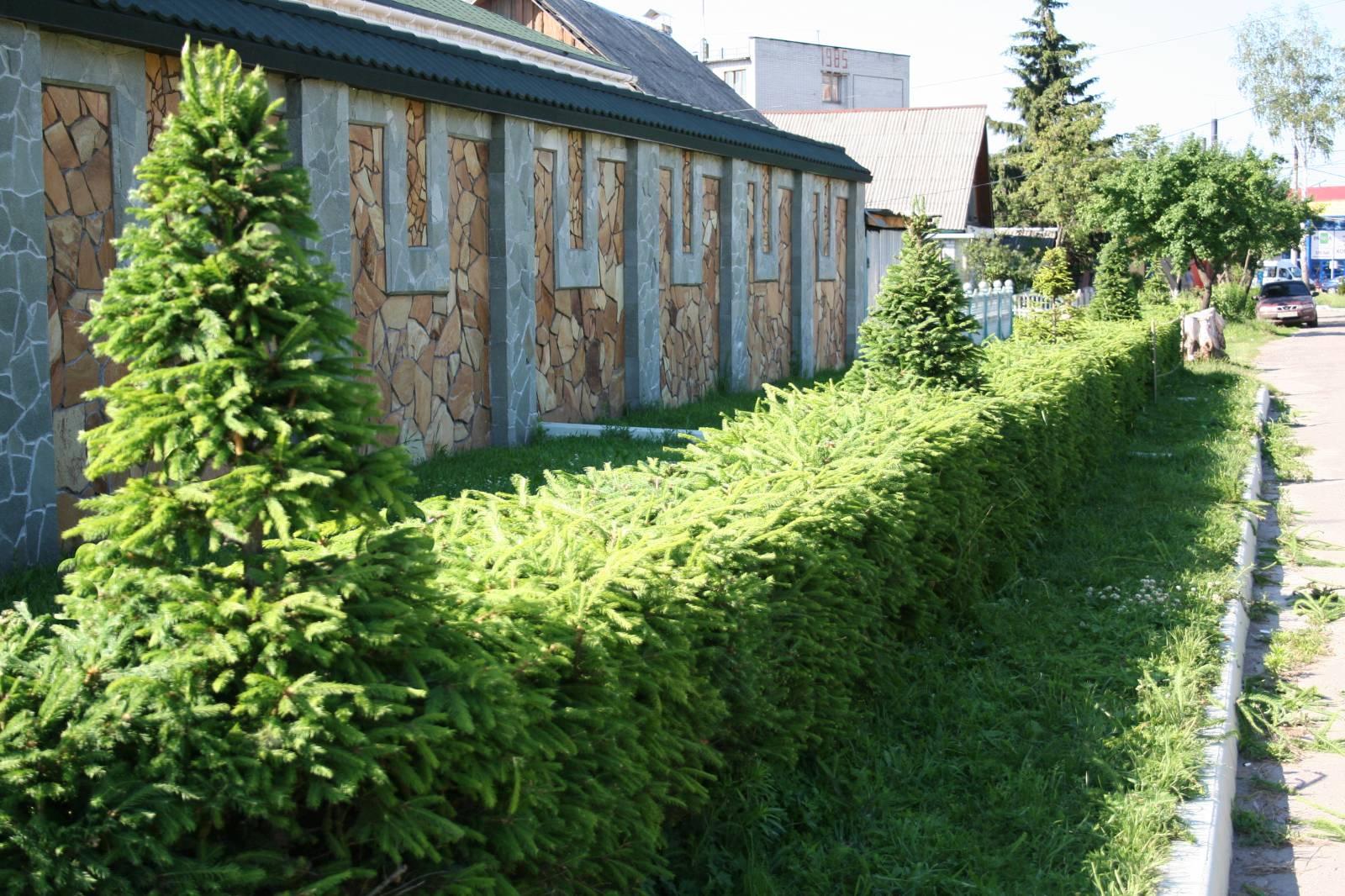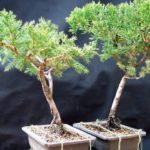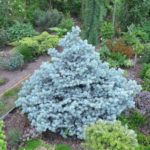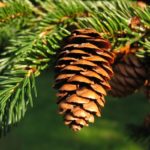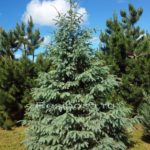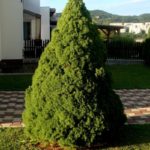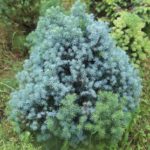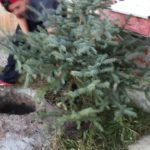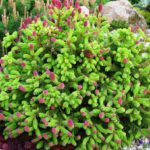Hedges are increasingly being created on personal plots. They can be a great alternative to an artificial fence because they have many benefits. Creating a hedge from spruce is considered a fairly popular solution in landscape design. This is due to the fact that it retains its attractive appearance throughout the whole year. In addition, such planting protects the yard from wind and prying eyes.
Is it worth making a fence from spruce?
A spruce fence has an attractive appearance and protects the yard from strangers. In addition, a hedge made of Norway spruce has many other advantages:
- The planting remains green for a whole year. It provides reliable protection and dense shade. In addition, these trees saturate the air with phytoncides.
- A dense spruce wall protects the area from dust, wind, and snow.
- Many types of spruce are adapted to harsh climates. This makes it possible to grow them in northern regions with long frosts.
- Young spruce trees are characterized by slow growth. Therefore, at first they do not need to be constantly formed. The plant is considered a long-liver, so it will be necessary to replant the plantings only after 35-40 years.
- To create a hedge, it is permissible to use wild and selectively bred varieties. This makes it possible to obtain a structure of the desired shape and height.
The disadvantage of this type of planting is the slow development of crops. To fully form a hedge, you will need to be patient. However, you should not expect a quick effect. In addition, the spruce fence needs to be constantly formed. This can be challenging for busy people.
What varieties to use
To create a natural decorative fence, it is permissible to use not every variety of plants. The most common and popular varieties of spruce trees include the following:
- Prickly - stands out among other varieties due to the unusual color of its needles. It may have a greenish-gray or dove-blue tint. Such spruce trees can reach a height of 25-30 meters, but there are also dwarf varieties. Young trees have a conical shape, while older trees become cylindrical.
- Eastern - this plant is characterized by small needles no larger than 1 centimeter in size. This crop can hardly tolerate severe frosts. At the same time, it is recommended to plant it in shady areas that have sufficiently moist soil. The plant grows slowly. Moreover, its life expectancy reaches 400-500 years. Under natural conditions, eastern spruce reaches a height of 65 meters.
- Gray - grows in height up to 15-20 meters. Moreover, its needles are 1-2 centimeters in size. At the top of the tree the crown is blue-green in color, and at the bottom it is blue-white. A striking representative of this species is the dwarf Alberta Globe variety, which has a spherical shape. The remaining varieties resemble a cone. This species is frost-resistant and unpretentious.
- Siberian - grows in forest areas of Siberia, China, Kazakhstan. This variety is also found in Northern Europe. This type of spruce is characterized by a pyramidal crown. At the same time, mature trees reach a height of 30 meters. Siberian spruce does not develop well in sandy and swampy soil. At the same time, it easily withstands even the most severe frosts.
- Purple spruce - this spruce comes from the highland forests of China. The name of the crop is due to the fact that its cones are purple in color. The tree is characterized by a cone-shaped crown. The plant reaches a height of 15-20 meters. It loves sunlight, but also grows well in the shade. The tree requires neutral soil. In addition, it perfectly perceives the influence of low temperatures.
- Ordinary - has become widespread in central Russia. The height of the plant can reach 30-50 meters. European spruce has fairly long needles that reach 2.5 centimeters.It is recommended to plant the tree in sandy or loamy soil. The annual growth is 50 centimeters. The plant is resistant to low temperatures in winter, but may suffer from spring frosts.
When choosing a variety, you should inquire about its suitability for growing in group plantings and resistance to frost. The height of the trees is also important. The optimal solution would be decorative varieties no more than 2-3 meters high. Larger crops will create an impassable thicket.
Landing requirements
To build a hedge, it is important to choose the right material for planting. The easiest way is to use ready-made seedlings for this.
Selection of seedlings
To grow a spruce with your own hands, you should buy seedlings that are 4 years old. Their height should be 1.5-2 meters. The younger the spruce, the faster it takes root. Seedlings are usually grown in containers. To make sure that the plant has not been transplanted there, you need to lift it a little. In a high-quality seedling, the root system and the soil form a single whole.
What scheme to plant?
The planting pattern is influenced by the size of the spruce variety. Typically trees are planted in 2 rows. This must be done in a checkerboard pattern. The following options are possible:
- The border is 40-50 centimeters high. In this case, an interval of 30-40 centimeters must be maintained between plants, and 40-50 between rows.
- The fence is 1.5-3 meters high. The distance between the spruce trees is 1 meter, and between the rows - 2-3 meters.
- The wall is more than 3 meters high.In this case, the gaps between trees and rows are 3-4 meters.
Soil preparation
To plant a spruce with your own hands, you need to choose the right soil. Spruce can take root in almost any substrate, but loam or sandy loam acidic soil is considered the optimal solution. The optimal acid-base balance is achieved naturally - thanks to the rotting of falling pine needles and bark particles. At the same time, clayey or too dense soil with a high content of nutritional components is not at all suitable for the tree.
Before planting plants, the soil needs to be prepared. In order for trees to take root, minerals with a minimum nitrogen content should be added. In order for the spruce to remain green for a whole year, it is forbidden to feed it with manure. Compost and vermicompost help to achieve good growth.
A drainage layer 20 centimeters thick should be placed at the bottom of the trench. Clay will help compact loose soil. To increase the breathability of dense soil, it is worth using sand.
Algorithm of actions
To plant spruce seedlings, you should do the following:
- Mark the area with string. Thanks to this, the hedge will be smooth. Dig a trench 40-50 centimeters deep along the bed. In this case, the bottom needs to be well loosened. Then it is recommended to water the soil.
- If the groundwater is high, add a drainage layer to the bottom. Its thickness should be 5-7 centimeters. A layer of soil of the same thickness should be placed on top and the soil should be watered a little.
- Dip the roots of bare-rooted seedlings into a mixture of manure and clay. The composition must first be diluted with water and any biostimulant added there.
- Plant spruce seedlings so that the root collar is flush with the ground surface. Sprinkle the trench with a composition based on peat chips and humus. These components should be mixed in equal parts.
At the end, the soil around the trunk must be well compacted. After which the plants must be watered abundantly. For 1 seedling it is required to use 15-20 liters of water. After it is absorbed, the soil needs to be mulched with sawdust, pieces of bark and fallen leaves.
How to care for a hedge
In order for the spruce fence along the site to develop normally, it needs to be watered and fed in a timely manner. To make the hedge look decorative, it is recommended to trim and shape the crown.
Watering
Blue and common spruce trees need timely moisture. It is recommended to moisten young plants once a week. In this case, you need to pour 1 bucket of water under each tree. If the hedge is large enough, it is worth organizing drip irrigation. To do this, it is recommended to use a hose with small holes through which water gradually flows out.
After watering, the soil must be loosened to retain maximum moisture and ensure air flow to the root system. Also, young seedlings need regular fertilization. During the first three years during the warm period, plants need to be fed 4 times with minerals.
Trimming
To make a spruce hedge look attractive and thick, you need to trim and shape the crown. It is best to carry out this procedure in the spring. During this period, the branches grow quickly. At the same time, a lot of fresh greenery is formed at the cut sites. If it was not possible to prune the spruce in the spring, the procedure can be postponed to the fall.However, it is important to do this on time - before the needles fall. In addition, dry branches must be removed throughout the summer season.
It is better not to touch spruce seedlings for a year after planting. This period is required for plants to take root. If necessary, only dry or diseased shoots should be removed. It is not recommended to cut off tree tops until the fence reaches the desired height. Then they need to be completely pinched off. Thanks to this, the spruce trees will begin to actively grow in width. Side shoots should be shortened by 30-50%.
To trim trees, it is recommended to use special garden scissors that have an elongated blade. After about 15 years, spruce trees begin to actively grow. At the same time, they need to be trimmed 2 times a year. When the tree reaches the required width, it is recommended to pluck out the central buds and shoots on the sides, but this should be done carefully.
Spruce pruning must be done in the form of a trapezoid. Thanks to this, the shoots of the upper and lower tiers will receive the same amount of sunlight. In this case, the needles will be preserved both above and below. At the same time, they will cover the tree trunks. If you give the plants a rectangular shape, the lower needles will experience a lack of light and crumble. As a result, the fence will lose its attractive appearance and lose its functionality.
A hedge made of spruce trees has excellent decorative properties. To get the desired result, it is important to choose the right seedling and strictly adhere to the rules for planting. Further care of plants is also of great importance. In order for a natural spruce fence to develop well, it needs to be watered and pruned on time. Young seedlings also need to be fed for several years.

